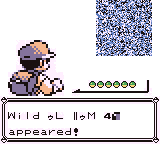Glitch: Difference between revisions
(Made more succinct and precise.) |
m (Bot: Adding es:Glitch) |
||
| Line 53: | Line 53: | ||
[[de:Bug]] | [[de:Bug]] | ||
[[es:Glitch]] | |||
[[fr:Bug]] | [[fr:Bug]] | ||
[[it:Glitch]] | [[it:Glitch]] | ||
[[ja:裏技・バグ一覧]] | [[ja:裏技・バグ一覧]] | ||
[[zh:遊戲漏洞]] | [[zh:遊戲漏洞]] | ||
Revision as of 22:25, 9 May 2018
A glitch, also known as bug, is a software error that can lead to unintended behavior in software like the Pokémon games. It can be triggered from mistakes within the game's code or by exploits that were not anticipated by the programmers, thus causing the game to react unexpectedly. Glitches present in Pokémon games can have a variety of effects, such as the disruption of graphics or audio effects, the appearance of glitch Pokémon, or the corruption of save data.
When noticed, glitches may be fixed by its developers in later releases of a game or derivative games. In some games, such as Pokémon Ruby and Sapphire and Pokémon X and Y, patches are released that fix glitches in Pokémon games directly.
Glitch Pokémon
- Main article: Glitch Pokémon
Glitch Pokémon are caused by glitches that have the game erroneously read placeholder data or non-Pokémon data as Pokémon data. Although many glitch Pokémon draw all their characteristics from data intended to be used elsewhere, some glitch Pokémon may have partially defined characteristics that are not intended to be accessed in-game: for example, in the case of MissingNo., its name is well-defined, but its base stats are read from data intended to represent the parties of several Bikers.
Glitch moves
- Main article: List of glitch moves
A glitch move is a move not intended to be part of the game, but accessible via glitches or cheating devices. While some glitch moves have no effect whatsoever, others may cause the game to freeze when attempting to perform them.
Usually, only glitch Pokémon will learn glitch moves. However, Ditto can be taught the glitch move -- by a glitch in Generation I. Additionally, another glitch present in the Time Capsule allows Pokémon that evolve by trading to be taught several glitch moves.
Glitch types
- Main article: List of glitch types
Glitch types are types that are solely used for glitch Pokémon or glitch moves. The Bird type is a leftover type thought to be a beta version of the Flying-type. All other glitch types are caused by erroneously reading other data as a type. Unlike regular types, glitch types often do not have any weaknesses, resistances, or immunities.
Glitch locations
There are several glitch locations which can only be reached by means of glitches or hacks. One of the most well known glitch locations is Glitch City. Several glitch locations part of the Sevii Islands are retrievable by their index number pointers and do not have any other data; only Sevii Isles 8 and 9 have actual map data. There are also other beta locations such as an unused Safari Zone in Generation II.
Glitch items
- Main article: List of unobtainable items
Placeholder items are often intentionally left in the game's code to prevent the game from crashing if the data is accessed, but without the intention to be accessible in-game. Placeholder items, such as the Teru-sama item in Generation II, often appear at the end of the games' internal item lists.
Placeholder items may become regular items in later games of a generation: The GS Ball, Clear Bell, and Egg Ticket, which only appear in Pokémon Crystal, are programmed into the games' internal lists in places of Teru-sama items in Pokémon Gold and Silver; if a corresponding Teru-sama is held by a Pokémon in those games, it will transform when being traded to Crystal.
Glitch items that will become regular items in a later game appear in Generation II and Generation IV. In Generation III, all items introduced in Pokémon FireRed and LeafGreen or Pokémon Emerald are stored in a section of the internal item list that is not accessible in an earlier game. Except for the Griseous Orb (which replaces a glitch item from Pokémon Diamond and Pearl), the same holds for all items introduced in Pokémon Platinum and Pokémon HeartGold and SoulSilver, as well as for all items introduced in games of a later generation.
Glitch Trainers
- Main article: Glitch Trainer
Glitch Trainers exist in Generation I and Generation II. They result from the game erroneously reading Trainer or party information from game code that is supposed to contain other information.
Glitch characters
In Generation I and Generation II, invalid values being interpreted as text (common in the names of glitch Pokémon and items) can cause portions of graphical assets, such as overworld tiles or HP bars, to be displayed as text.
See also
- List of glitches in Generation I
- List of glitches in Generation II
- List of glitches in Generation III
- List of glitches in Generation IV
- List of glitches in Generation V
- List of glitches in Generation VI
- List of glitches in Generation VII

|
This article is part of Project GlitchDex, a Bulbapedia project that aims to write comprehensive articles on glitches in the Pokémon games. |
